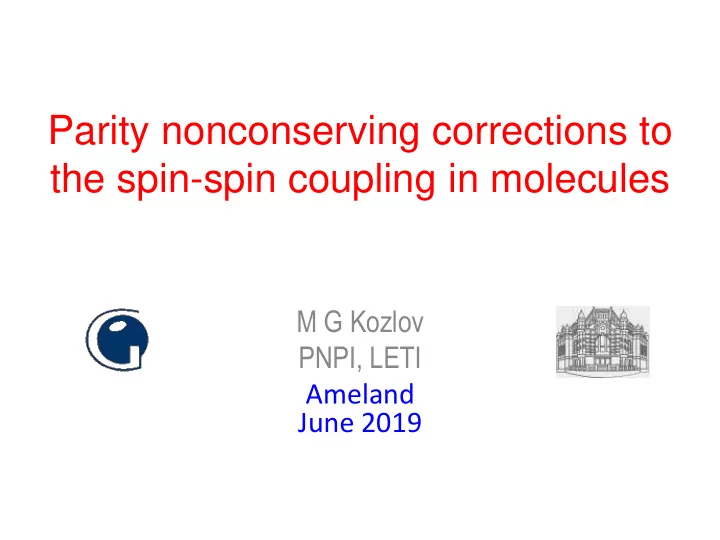

Parity nonconserving corrections to the spin-spin coupling in molecules M G Kozlov PNPI, LETI Ameland June 2019
J -coupling in molecules • Tensor form of the direct dipole-dipole interaction: 𝑱 1 𝑼 (2) 𝑱 2 • Direct dipole-dipole interaction between nuclear magnetic moments is of the order of 2 1 𝑛 𝑓 𝛽 2 𝑆 3 ~MHz 𝑛 𝑞 • Indirect nuclear spin-spin interaction ( J-coupling ): 𝑲 = 𝑲 (0) + 𝑲 (1) + 𝑲 (2) 𝑱 1 𝑲𝑱 2 ; • Indirect nuclear spin-spin interaction is of the order of 2 𝑛 𝑓 𝛽 4 𝑎 1 𝑎 2 < 100kHz 𝑛 𝑞 • Only scalar J-coupling survives averaging over molecular rotation.
Vector coupling without P-odd interaction If parity is conserved, then J (a) must be an axial vector. Non- degenerate electronic state is described only by polar vectors, such as nuclear radii R i , therefore 𝑲 (𝑏) = 0 . J (a) J (a) R 3 inversion R 1 R 2 R 2 R 1 R 3 To have vector coupling J (a) we need chiral molecule with two degenerate states linked by inversion.
Vector coupling with P-odd interaction • If parity is not conserved, then J (a) can be a polar vector, which is fixed in molecular frame. In this case we can have vector coupling already in diatomic molecules, where 𝑲 (𝑏) ~𝑺 12 . P-even P-odd J (a) J (a)
Experiment to observe vector coupling • In the molecular stationary state expectation value is zero. We need to look at the correlation signal rather than frequency shift. • Correlation 𝑱 1 × 𝑱 2 ∙ 𝑲 (𝑏) is similar to P-odd correlation 𝑱 1 × 𝑻 ∙ 𝒐 , which can be observed in diatomic radicals [Yale group: S Cahn, D DeMIlle et al ]. • We can polarize molecule in electric field, then 𝑲 (𝑏) ~𝑭 . We also need to decouple spins from each other.
Recent proposal of NMR experiment [JP King, TF Sjolander, & JW Blanchard, J.Phys.Chem.Lett., 2017 , 8 , 710]
PV interaction in nonrelativistic approximation Atomic units: Nuclear-spin-dependent PV interaction: In the external magnetic field
PV interaction in the magnetic field of a nucleus Second term gives direct contribution to antisymmetric J -coupling! [Barra & Robert, MP, 88, 875 (1996)]
PV contribution to J -coupling Electronic ME does not include spin, or momentum. Therefore, the main contribution comes from 1s shell.
Estimate of PV contribution to J -coupling Typical internuclear distance R is few a.u. Assuming R =4 and Z =80 we get:
Contribution of the first term of PV interaction to J-coupling The second-order expression for the J (a) has the form: For 𝑎 𝑀 ≪ 𝑎 𝐿 this is smaller than first order term.
Relativistic operators PV weak interaction has the form: There is no dependence on the second spin here and we need to consider second-order expression with H HF :
Relativistic expression for J (a) The sum over states includes positive and negative energy spectrum, σ 𝑜 = σ 𝑞𝑝𝑡 + σ 𝑜𝑓 . In the second sum we can substitute energy denominator by 2 mc 2 and use closure: This gives us effective operator:
Relativistic correction
Two examples TlF HF Z = 81, Z = 9, R = 2.08Å = 3.9 a.u. R = 0.92Å = 1.7 a.u. γ F =5. 12 μ N =2.0 10 -5 γ H =5.58 μ N =2.2 10 -5 F rel =7.6 F rel =1.0 Tl =3.0 10 -18 a.u. H =3.0 10 -21 a.u. J (a) /g (2) J (a) /g (2) = 20 μ Hz = 20 mHz
Conclusions on J-couplings • PV nuclear-spin-dependent interaction leads to antisymmetric vector coupling of nuclear spins in diamagnetic molecules. • We can get analytical expression for this coupling. For heavy diatomic molecules it is of the order of 10 mHz. • PV vector coupling can be observed in NMR experiment in the liquid phase in external electric field.
PNC effect in NMR spectroscopy of chiral molecules [Eills et al PRA 96, 042119 (2017) ]
Relativistic operators PV weak interaction has the form: There is no dependence on the second spin here and we need to consider second-order expression with H HF :
Collaborators • John Blanchard • Dmitry Budker • Jonathan King • Tobias Sjolander
Thank you!
Recommend
More recommend